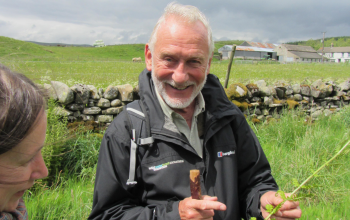Professor Sir John Lawton urges landscape scale thinking for nature recovery
Author of the landmark ‘Making Space for Nature’ report, world renowned ecologist, Professor Sir John Lawton urges landscape scale thinking for the UK to recover and regenerate nature, and as part of this, to successfully deliver a minimum of 30% of land and sea protected for nature by 2030 (30 by 30). The UK Government made this commitment as part of the United Nation’s Leaders’ Pledge for Nature in September 2020 – 95 other nations have also pledged to deliver 30 by 30.

Professor Sir John Lawton
Last week, the Secretary of State for Environment, Food and Rural Affairs, Steve Barclay, announced the 34 successful projects in the second round of the Landscape Recovery Programme. I’m delighted to see an acknowledgement of the need for action for nature on a landscape scale and this investment (£25m) in habitat restoration projects.
This is without doubt a positive move in the direction of successful delivery of the Government’s 30 by 30 pledge. This global commitment and the attention it commands has the potential to galvanise action at scale to halt the continued decline in nature we’ve experienced over the past 50 years.
In 2009, the Government asked me to prepare a strategy to address the nature crisis. The result of this was the 2010 Making Space for Nature report, in which I called for more, bigger, better and joined up spaces to be allocated and protected for nature. ‘Joined up’ does not have to mean contiguous; by using stepping stones of restored habitat, buffer zones and wildlife corridors, this is relatively easy to achieve. My recommendations still hold true but the urgency to respond increases with every passing day.
Landscape scale delivery is what makes the real difference, and I urge Government not to focus on hitting the target while missing the point.
Professor Sir John Lawton on nature restoration

Pearl Bordered Fritillary butterfly - Simon Smith
We know too, the effects of climate change are accelerating the rate of nature depletion. The UK’s kittiwake population has declined by 70% since 1986 as climate change has reduced the availability of sand eels, a key food source in breeding season. 48% of moth decline and 60% of aphid decline is due to climate change.
National Landscapes cover some 14% of England’s land area, and the National Parks cover around 8%. It’s tempting to suggest we’re not far off 30% already. But designating land for the public good doesn’t automatically mean that land is protected for nature. National Landscapes Partnerships own no land, so habitat restoration is a complex activity requiring the coordination of successful grant applications and coordination of many stakeholders – landowners, farmers, parish councils, colleagues in partner organisations who own land such as the National Trust – to deliver across a landscape.
This landscape scale delivery is what makes the real difference, and I urge Government not to focus on hitting the target while missing the point. If we focus on that 30% figure in isolation, we risk prioritising the ‘more’ aspect of my recommendations at the cost of the equally important ‘bigger, better and joined up spaces’ for nature. If we don’t take a landscape scale approach, with the funding to match the ambition, we are letting nature down, and failing to deliver for nature is ultimately the death knell for humanity too.

Girls on a school trip enjoy time in Arnside & Silverdale National Landscape - Ella Riden
Humankind is part of the ecosystem, and this is included in the International Union for the Conservation of Nature’s own definition of a protected landscape/seascape which acknowledges the integral balance between people and nature. A healthy environment rich in nature is not a luxury, it’s fundamental to our existence. The habitats wildlife needs to thrive are also what people need for clean air, clean water, for flood defence, for natural places to visit that bring health benefits as well as inspiration and joy.
Steve Barclay’s announcement of 34 new Nature Recovery projects to join the 22 announced earlier this year signals the direction for the kind of approach we need to deliver 30 by 30 and this gives me great hope that the Government really understands the scale of the problem.I know from personal experience the difference a landscape scale approach can take.
As the chair of North Pennines National Landscape’s Tees-Swale: naturally connected programme (a joint project with the Yorkshire Dales National Park, funded by the National Lottery Heritage Fund) I can say that the collaborative approach – which is very much in the DNA of the understaffed National Landscapes teams, is an exemplary approach to delivery of ‘more, bigger, better and joined up’. Tees-Swale sees North Pennines National Landscape Partnership and Yorkshire Dales National Park Authority working in partnership with farmers and landowners across an 845 sq km area to put farming at the heart of nature and nature at the heart of land management.
